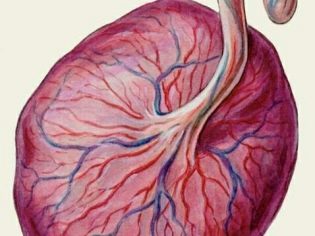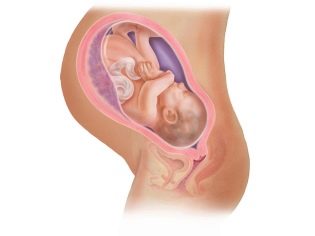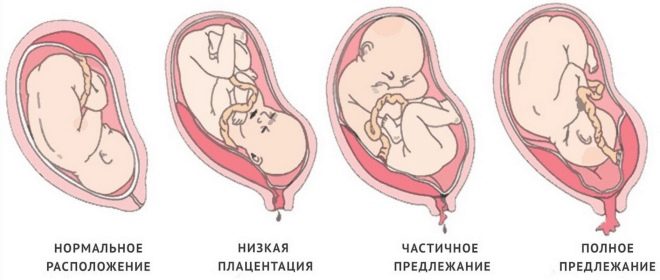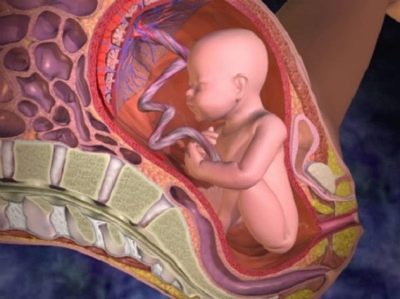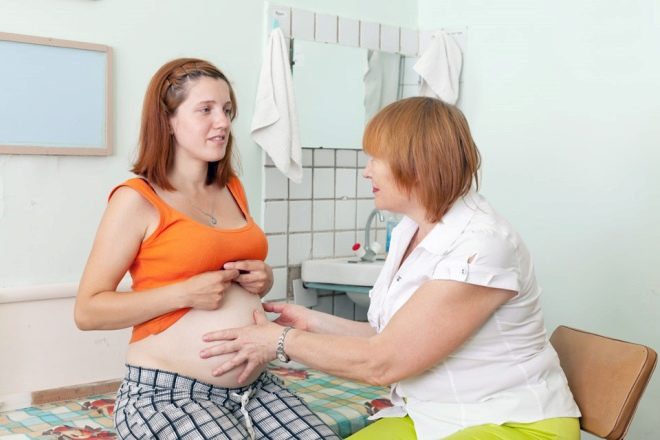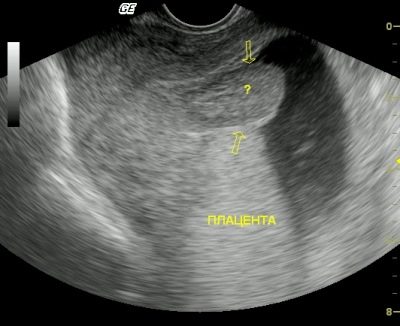What does the location of the placenta on the back wall of the uterus mean and what does it affect?
For full intrauterine development of the fetus, the placenta is necessary. It can be located in the uterus in different ways. This article will help to understand what means the location of the placenta on the back wall of the uterus, and what it affects.
What does mean?
Placental tissue during pregnancy is laid early enough. Already in the second trimester of pregnancy, it begins to function fully. In the placenta there are various blood vessels through which the fetus receives the nutrients necessary for its growth and development, as well as dissolved oxygen.
How the placenta is attached to the uterine wall depends on how the intrauterine development of the baby will proceed, as well as the course of the pregnancy as a whole.
The location of the placenta and its initial localization are determined almost from the first days after conception. It all depends on where the fertilized egg will be located. In most cases, it is implanted (tightly attached) in the inner wall of the uterus in the area of its bottom along the back wall. This feature of implantation is due to nature. It is established that in this zone the most good blood flow.
The presence of blood vessels in this anatomical zone of the uterus contributes to the physiological growth of the chorion. In such a situation, it quickly and fully grows and develops. Note that in most clinical cases the placenta is located quite high on the back wall of the uterus - practically in the uterine region, that is, in its upper part. The distance to the inner uterine mouth is quite large.
In certain situations, the fertilized egg changes its place of attachment and is implanted in the lower sections of the uterus. This situation can be dangerous and usually leads to the development of a low location of the placenta or presentation.
Normally, there is a certain distance between the placental tissue and the internal pharynx. At each stage of pregnancy it is different. So, normally in the 2nd trimester of pregnancy it is 5 cm, and by the third it changes to 7 cm.
If the placental tissue is almost completely adjacent to the internal fallopian pharynx, and even directly finds it, then this pathology is called the positioning.
Doctors distinguish several clinical variants of placenta previa: it can be central, lateral or marginal. It all depends on which zone the placental tissue is shifting to the area of the internal uterine throat.
Thus, the central presentation is characterized by a shift of the central part of the placenta to the area of the internal os. When the side previa placenta in contact with the pharynx from the region of the side walls, and at the edge - only a few edges.
Also, placenta previa can be complete and partial. With full previa, almost all placental tissue is in the area of the internal uterine throat. If the placenta is in contact only with individual sections (parts), then such presentation is called partial or incomplete.
The severity of adverse symptoms and possible complications while significantly depends on how the placental tissue is located relative to the internal uterine throat. This determines the nature of the course of pregnancy. Experts note that the attachment of the placenta on the back wall of the uterus occurs in most clinical cases.
Features of the course of pregnancy
With the normal location of the placental tissue on the back of the uterus at a considerable distance from the fallopian pharynx during pregnancy usually proceeds quite physiologically. A good blood flow in the bottom of the uterus and its posterior wall ensures optimal growth of the fetus. In this situation, the risk of developing any complications and adverse effects is quite low.
If the placental tissue for some reason is displaced along the back wall below and reaches the internal os, the course of the pregnancy is already complicated by the development of presentation. In this situation, the risk of developing undesirable complications increases significantly.
It is important to note that placenta previa on the back of the uterus is more favorable. The prognosis for pregnancy in this case is quite good.
Thus, the risk of developing mechanical damage to placental tissue, which is located on the back wall, is much lower. This is due to certain anatomical features of the structure of the female body. The anterior abdominal wall and pelvis bones protect the placenta in front, and the backbone skeleton in the back. Such reliable protection minimizes the possible trauma of tender placental tissue.
Is migration of the placenta possible?
The change in the initial localization of the placental tissue is called migration by specialists. It usually lasts for several weeks and is not accompanied by the development of adverse symptoms. However, during pregnancy, proceeding with placenta prevailing on the back wall of the uterus, the possibility of migration of placental tissue, unfortunately, is extremely low.
Many obstetrician-gynecologists believe that in this position, the placental tissue practically does not change its initial localization. Only in extremely rare cases, its migration is possible.
In this case, a pregnant woman is very important to monitor their health. The appearance of bleeding during the 2-3 trimester of pregnancy, especially spontaneously developed, should be a significant reason for an urgent appeal to a specialist. In this case, there is a high risk of bleeding or even placental abruption.
How to determine?
The location of the placenta can be established in various ways. Thus, the localization of the location of the placental tissue is determined by conducting the usual routine vaginal examination. The doctor, conducting such an examination, must necessarily assess where the placenta is located.
If the placental tissue is too low and develops its presentation, then perform too frequent vaginal examinations should not be. In this case, you can easily damage the delicate tissue of the placenta. It is also very important that vaginal examinations be carried out by a qualified specialist. Accuracy in carrying out such gynecological examinations is very important.
A more accurate way to determine the location of the placenta is an ultrasound examination. With the help of modern equipment it is quite easy and accurate to determine where the placental tissue is located. An experienced and qualified specialist can also quite easily determine the distance from the placenta to the uterine throat.
If during pregnancy a diagnosis of placenta previa is established, then in this situation a few more ultrasound examinations are scheduled for the expectant mother. This allows doctors to follow the dynamics of the course of pregnancy, as well as in time to establish the beginning of the formation of possible complications.Such an ultrasound examination in dynamics allows us to estimate the migration of placental tissue, if it still happens.
If there is a placenta previa, then transabdominal ultrasound techniques are preferred. During their conduction, the ultrasound sensor is located on the surface of the anterior abdominal wall.
Performing a transvaginal ultrasound when the sensor is inserted into the vagina may result in bleeding. As a rule, when presenting this examination and not carried out.
How is the birth?
When choosing the tactics of obstetrics, the localization of the placenta before childbirth plays an important role. If it is quite high, and the pregnancy is physiological, then in such a situation, doctors can resolve natural childbirth. In this case, the child is born without the use of cesarean section.
If the placenta, located on the back wall of the uterus, is too low or even has its presentation, then in such a situation, the option of carrying out a surgical method of obstetric aid is already being considered. In this case, a caesarean section is usually required.
It should be noted that such a curative surgery is carried out in order, above all, to preserve the health of the mother and her baby.
Also, a cesarean section is carried out and those women who have a complicated obstetric and gynecological history. The presence of severe concomitant chronic diseases is an important reason for prescribing a cesarean section. In this situation, natural independent labor may be too dangerous.
An important goal in the management of pregnancy, complicated by the development of placenta previa on the back wall of the uterus, is its possible maximum long-term preservation. In such a situation, a baby born into the world is more functionally adapted for life in a new habitat.
The choice of obstetric aid tactics is individual. This is influenced by a huge variety of different factors. Tactics of pregnancy, complicated placenta previa on the back wall of the uterus, may change several times over the entire period of the baby's birth.
What should be considered?
Pregnancy, in which the placenta is located on the back of the uterus, usually proceeds well. However, this does not exclude the planned visits to the doctor and the screening tests recommended by him.
During the carrying of the child in the female body can occur numerous changes. At any time, even a physiological pregnancy can be complicated by the development of complications. In order for them to be identified on time, the expectant mother should regularly visit her obstetrician-gynecologist.
If during the examination the doctor determines the placenta previa, then, first of all, you should be very careful about this. The behavior of the future mother and her attitude towards her own health are a very important component for such a pregnancy.
The appearance of bloody discharge from the genital tract, the occurrence of a sudden and severe pain syndrome in the abdomen should be an important reason to consult a specialist.
When placenta previa on the back of the uterus, doctors make a number of recommendations. They are mainly aimed at reducing the development of dangerous complications, such as the occurrence of bleeding or placental abruption. The future mother, who has a placenta previa, should not lift heavy objects and actively engage in physical activity. Also, in order to improve overall well-being, she should fully eat and get enough sleep, and also, if possible, limit any stress and nerve shocks as much as possible.
You will learn more about the importance of the location of the placenta in the following video.


